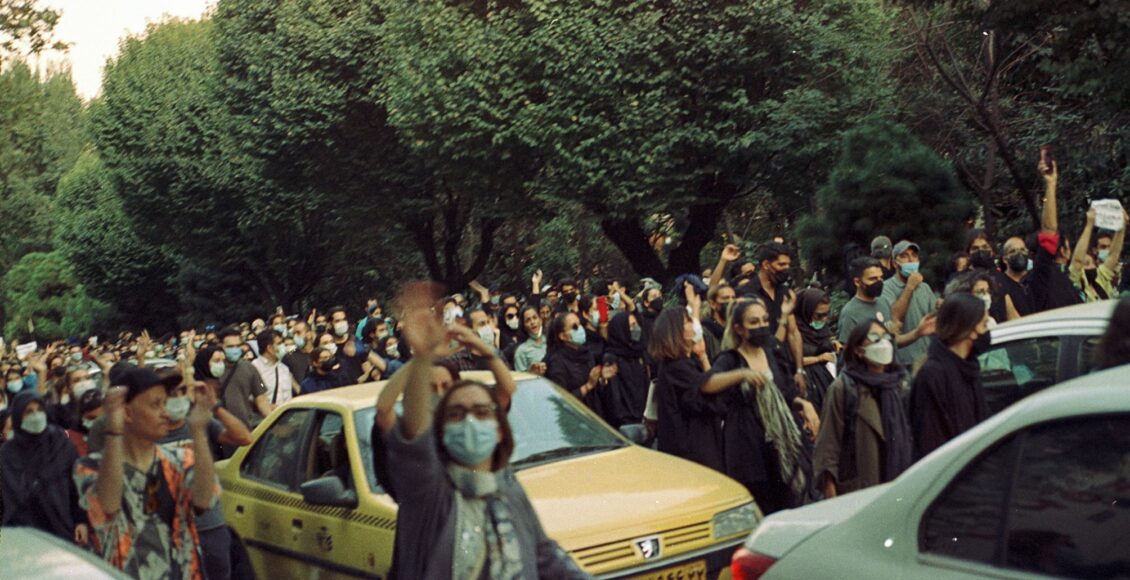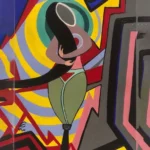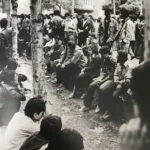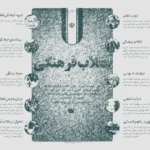/Review Article | Reading Time: 12 minutes
Engaging with some Articles on
the Women, Life, Freedom Movement
Ferdos Sheikholislam | December 15, 2024
© Background Photo by Mohammad Moghadasi
ISSN 2818-9434
During and after the Jina Uprising, many articles were written about this uprising by various experts and social activists, which are important to analyze and review from the perspective of understanding this event and evaluating the current currents of thought in the public sphere of Iran. The present paper is a review of the articles written by ten of these scholars and socio-political activists about this uprising. I have compared these articles from four perspectives: 1) their view of the rupture and continuity of this uprising with the movements that preceded it, 2) its distinctive features, 3) its main demands and themes, and 4) the future they envision for this movement.
In selecting these authors, I have considered three criteria in order to represent an acceptable diversity of intellectual perspectives on this protest movement. These criteria include: 1) the different areas of activity and expertise of the authors, 2) the coverage of different time periods, from the midst of the protests in the streets to the present, and 3) the coverage of intellectuals and activists living and non-living in Iran. The list and specifications of the reviewed articles by each author are given at the end of the article, but here I will mention the names and expertise of these authors according to the time of publication of their contents:
-Fatemeh Sadeghi (Gender and Political Science scholar, University College London), October, December 2022 and January 2023.
-Amirhossein Ali Bakhshi (Ph.D. Student, Sociology, University of Tehran), January 2022
-Ebrahim Towfiq (Former Professor of Sociology, Allameh Tabatabai University) and Mehdi Yousefi (Researcher of contemporary history), January 2022
-Asef Bayat (Professor of Sociology, University of Illinois-Champaign), March 2023
-Mahsa Tafsiri (pseudonym), March 2023
-Azam Khatam (Sociologist and Researcher, University of Toronto), November 2022, February 2023
-Pedram Amirian (PhD Student, Public Law, Shahid Beheshti University), April 2023
-Noushin Ahmadi Khorasani (Women’s Activist and Writer), August 2024
-Niloofar Rasouli (Journalist), September 2024
Traces of the past and a break from it in the historical perspective
Most of these writers have referred to what they consider to be the backbone of Jina’s moment from a historical perspective and have used trends and events from this historical past in the configuration of their analysis in accordance with their viewpoint. This critical review of the Jina movement (also known as Woman, Life, freedom Movement) and the forces that were liberated through it included the Constitutional Revolution of 1906, the 1979 Revolution, the policies of the reconstruction and reform era, the Green Movement of 2009[1], the January 2017 protests[2], Vida Movahed’s action[3] and the Girls of Enghelab Street movement in 2017[4], the November 2019 riot, and even the arrest of Sepideh Rashno[5] and the social reaction to it. However, almost all these writers believe that no matter how much we want to see the Jina uprising as part of the process of fundamental changes resulting from these events and see it as a link in the chain of protests of the past years, its significant differences cannot be ignored. A general perception is that the protests and socio-political movements of recent years, each expressing the concerns and dreams of certain strata and classes and gradually turning into pent-up anger and the repressed aspirations of various peoples, crystallized in the Jina movement. A recurring phrase in the texts is the interpretation of the Jina uprising as the reaction of Iranian society to “humiliation” in its various forms: the reaction of those who are humiliated because of their language, religion, and geography, or because of their gender, or because of their poverty, or because of their lifestyle. That is why each previous uprising left its mark on the Jina uprising. But at the same time, the authors acknowledge that Jina is not a simple collection of past desires and discourses.
Distinctive features of the Jina Uprising
But how are the characteristics of the Jina movement, beyond its focus on the rejection of humiliation and discrimination, reflected in these texts?
The closer the articles are to the burning emotions in the streets and the fever in universities, schools, and social networks, the more passionate and excited the writing is, and are full of fear and hope. They agree that Jina’s uprising is against any supernatural guardian, transcendent concepts, external savior, or a superior other, such as the Father.
Other notable features highlighted in the papers include the pioneering role of women and the influence of feminism in the Jina uprising. The authors interpret this as a rejection of the self/other dualism and an opposition to the politics of death and resentment (Sadeghi, 2022, 2023; Ali Bakhshi, 2022; Ahmadi Khorasani, 2024). They also emphasize the diversity and novelty of the protest forms, as well as the way the movement fosters intergenerational dialogue among genders and families about compulsory hijab (Bayat, 2023; Khatam, 2022). These demands, according to the authors, align with the core message of the slogan “Woman, Life, Freedom.”
In the analyses written close to the event, the idea that the movement has transcended mythical dualities, familiar ideologies, and state-centered struggles and wants to pursue politics outside of the centralized and homogeneous government order is very pronounced. They were the days when streets were stunned and promised liberation. Criticism, if any, was mostly expressed in warnings and advice. However, the further we move away from the peak of the Jina movement, the more critical the texts become. This is while praising that moment and the subjective and objective possibilities it created. With the passage of time, the hopeful dimensions of the uprising were abandoned due to reasons such as the lack of specific alternatives, the lack of structure of the movement, and to some extent the growth of the monarchist opposition and their claims to its leadership (Amirian, 2023; Ahmadi Khorasani, 2024).
What does the crowd on the street want?
Since the central theme of the Jina uprising is “rebellion against humiliation”, from the authors’ point of view, the demands for freedom, equality, and the restoration of human dignity have brought people to the streets. However, there is no complete agreement on the dimensions of these rebellions and the discriminations that have played a central role. For example, there are debates about whether compulsory hijab and violence against women have really been the main trigger and subject of the protests, or whether they have simply become a symbol of other discriminations. I think that at least half of the analysts believe that society concluded that its freedom depends on women’s freedom. This point is even more prominent in the analyses written in the midst of the protests. But do all writers see a direct relationship between the demand for women’s liberation and the deconstructive character of the uprising?
In three notes she wrote from October to December 2022, Fatemeh Sadeghi considered Jina a feminist movement to reclaim life and stop police brutality. In her view, the protesters expressed their hatred of the regime’s repressive ideologies by declaring that women’s compulsory hijab is “evil.” Asef Bayat’s analysis in March 2023 is close to this view in some ways, although he pointed to the secular aspects of the uprising and the presence of various strata, and as a result, he considered the demands of the Jina movement to be irreducible to compulsory hijab and beyond women’s issues. In his view, the traces of structural change in this movement are quite visible, although he doubts that it can be considered a revolution. In his opinion, elements such as the intellectual and heartfelt support of parents and middle-aged people for the youth, the sporadic but parallel labour strikes, the high participation of teachers, and the reactions of the regime are indications that this movement could be the beginning of a revolution or a revolutionary movement.
Mahsa Tafsiri wrote a remarkable note at the same time stating that political overthrow should not be put on the shoulders of this movement. She considered the central demand of the Jina uprising to be the optional hijab and stated: “This is uprising is not a revolution because young girls and boys, whether students or students, are not the pawns of any political group. In her view, Jina’s moment unleashed new imaginations, but this is not enough for a fundamental change, and the protesters need specific strategies. In contrast to Bayat, she argues that Jina cannot unite all social groups in order to change the government in the short term. However, it can shake religious fundamentalism in the country and the region.
Azam Khatam in her November 2022 article, depicts the movement in an oscillation between the Cultural Revolution and the Social Revolution, in which the youth are the driving force. Referring to youth crisis in Iran, especially the impossibility or difficulty of navigating adulthood and starting an independent life for the majority of them, she sees the prospect of structural change for this uprising. In an interview with Enkar Internet journal in February 2024, she emphasizes the change in the relationship between the government and the youth in the 2020s compared to the 1990s, and that the movement grew as a result of crises caused by the political economy of youth and the discipline of the female body. According to Khatam, the increase in street violence against young people following the 2021 elections only intensified the Iranian youth crisis. Although she considers the Jina movement as a continuation of the resistance against the disciplining of women’s bodies, she considers the current discourses in it to be more than resistance and believes that these discourses range from the right to a normal life, the rule of democracy and pluralism, to the desire to integrate into global culture and the nostalgia of the Pahlavi era.
Yet, in their joint paper written in January 2023, Ebrahim Towfiq and Mehdi Yousefi addressed intellectuals and analysts. In their view, the Jina movement should not be reduced to liberal demands. History should not be considered a linear and straightforward course to which the current uprising is struggling to return, and women and youth are mediators of the transition. They consider Iranian society too mature to worry about taking over the government and replacing existing rulers with new ones. In their view, Jina is a struggle to create alternatives to politics in many different fields (schools, universities, ethnicities, etc.).
The Outcome of the Movement
The way of looking at the end of the movement in articles can be relatively divided into two groups:
- Arguments that take into account the structural and fundamental change in the balance of power, assess the possibility or impossibility of the transition process, and predict two important risks in the way as shall be seen.
- Analyses that pay attention to the achievements and contradictions of the movement from the perspective of guardianship relations within the society and enumerate more conflicts and dangers for it.
In March 2023, when there may have been a prospect for a change in the political order, Bayat wrote that fundamental change requires the participation of all classes and ages (workers, merchants, specialists), having a credible and specific alternative, a leadership organization (perhaps temporary) with broad national backing, both with the aim of negotiating with the existing government for a peaceful transition to the new order, and for the Jina movement not to be stolen by opportunistic forces. From his point of view, and somewhat different from analysts like Ahmadi Khorasani, the cycles of protest and repression will continue until a situation in which a dual power is formed, and this is inevitable. Unless the government undertakes radical political reform and the people feel a meaningful improvement in their lives.
According to Sadeghi, Amirian, and Khorasani, who evaluate the movement in terms of the balance of power and the political system, the counter-revolution can be rebuilt, and authoritarianism can continue. They refer to the 1979 revolution and learning from similar protest movements in the region, especially in countries of the same fate. They stress the importance of protecting freedom, preventing counterrevolutionary forces from taking power, and understanding leadership within authoritarian societies. It is in this context that Fatemeh Sadeghi asks how to stop the cycle of revolution and dictatorship, how can the revolution be tied to freedom? Iranian women have experienced effective participation and then being pushed back during the Constitutional Revolution and the 1979 Revolution. Thus, we must think about how radical political change will guarantee women’s rights.
Pedram Amirian also asks about the nature and fate of the people’s founding power and how to advance the political process that leads to it. Some of these authors, including Ahmadi Khorasani, Bayat, and Sadeghi, emphasize the importance of organizing, creating a coalition of progressive forces, protecting freedom, and establishing a common political project: a coalition of pro-democracy advocates that emphasizes social justice, secularism, and ethnic pluralism. From this perspective of the balance of power, but not only by emphasizing the possibility of a political situation, Ahmadi Khorasani reminds us of the need to think about institutional mechanisms that establish democratic and moral relations with the pluralistic forces of society.
Attention to the issue of self-proclaimed leadership in this uprising and its dangers has gone beyond the writers who have generally paid attention to the issue of the return of the counter-revolution and the restoration of authoritarianism. In fact, all of these writers have devoted parts of their article to describing the role of the opposition outside the country, especially the monarchists, and have warned their readers against their words and strategies: the illusion of power, the emphasis on mere overthrow, the replacement of one patriarch with another, the lack of relationship with Iran’s pluralistic and dynamic society, and the lack of a clear roadmap for getting out of crises other than resorting to sanctions and military intervention from the outside (Ali Bakhshi, 2022; Sadeghi, 2022; Amirian, 2023). Ahmadi Khorasani emphasizes that this group has made the issue of women a tool for the transfer of power, but they do not clarify their relationship with individual and civil liberties and open the way for violent activists with an enemy-making discourse based on elimination. Khatam, however, does not consider the relationship between the Iranian people and foreign media to be one-sided. In her opinion, the discourse of “normal” life in this movement means for some people integration into the “world culture”, while others mean passing through the totalitarian nature of politics. Although some people are nostalgic for a return to the Pahlavi era, society is sensitive to external interventions and has enough time for a mental transition from any kind of totalitarianism (Khatam, 2023).
One of the significant aspects of Towfiq and Yousefi’s discussion is the critique of the dehistoricity of the events and the ideology of the transition. They ask whether the social forces active in moments such as the Jina and even the Constitutional Revolution, only sought to bring the nation under one government with whatever name it might have had. Towfiq and Yousefi criticize Javad Tabatabaei’s writing about the “Iranshahri”[6] nature of the movement and remind Hannah Arendt’s distinction between freedom and equality. In their opinion, there is a strong tendency to new and self-centered forms of political action among the people, who are neither homogeneous nor sympathetic to homogeneity.
As I mentioned previously, some analysts have paid attention to the internal challenges of the movement, beyond the issue of its self-proclaimed leadership. The continuation of the movement is one of these internal challenges. Sadeghi (2022), Ali Bakhshi (2022), and Amirian (2024) emphasize the preservation of hope for social and democratic potentials that are not going to be realized once and for all, as well as the transformation of the subjects of anger into objects of change. They call on activists to redefine the idea of the state as one of the mediators of society, in a way that serves the public and social cause and guarantees the realization of a wide range of the rights of the outcasts. Another concern of the authors is to redefine the political as a matter of citizenship, rather than an arena of political conflict between rulers and elites.
Ahmadi Khorasani (2024) addresses the challenge of the continuation of the Cultural Revolution from the perspective of freeing women’s bodies from the familiar, simplistic, absolutistic, and recurring dichotomies that have become a confrontation between Western-oriented modernism and anti-Western Islamism throughout contemporary history. Here, the challenges arising from highlighting ethnic and religious identities in the face of the common experience of women’s oppression and disenfranchisement at the intersection of these identities are emphasized. Niloofar Rasouli (2024) raises her concern about any patriarchal hierarchy that makes it difficult to reread resistance as rejected bodies. She points to invisible bodies that are not tamed, do not submit to discipline, and whose resistance is unpredictable. Like Towfiq and Yousefi, Rasouli wants historiography to be based on dominant and elitist theories and reminds us that the history of the Iranian women’s movement contains an important and valuable tradition of turning the state violence into resistance, which is worth remembering in order to continue on the path.
In conclusion , I would like to emphasize the writers’ hope for Iranian society, regardless of the different emphasis they have placed on the achievements and concerns of the uprising. This hope stems from the diverse and extensive experience of Iranian society in uprisings in its contemporary history, which the authors consider their critical review as inevitable for understanding the present and imagining the future.
Bibliography
Ahmadi Khorasani, Nooshin. “The Common Enemy” and Women’s Liberation.” Enkar. 2024.
Ali Bakhshi, Amirhossein. “Woman-Life-Freedom,” Enkar. 2022.
Amirian, Pedram. “I’d rather not…!” Enkar. 2023.
Bayat, Asef. “Is Iran on the Verge of Another Revolution?” Zeitoons.com. 2023.
Khatam, Azam. “Street Politics and the Hijab in the Woman, Life, Freedom Movement.” Pecritique. 2022.
——. “The crisis of youth and the creation of a space for autonomy.” Enkar. 2023.
Rasouli, Niloofar. “Weed and the Injured Knees.” 2024. https://harasswatch.com/news/2355/
Sadeghi, Fatemeh. “The Fall of the Wall: A God Who Never Returns.” Pecritique. 2022.
——. “From Women’s Revolution to Feminist Democracy.” Pecritique. 2022.
——. “Horizons of Woman, Life, Freedom.” Enkar. 2023.
Tafsiri, Mahsa. “The Woman, Life, Freedom Movement – From Empathy to Synchronization and Deepening.” Radio Zamaneh. 2023.
Towfiq, Ebrahim, and Mehdi Yousefi. “Woman-Life-Freedom: The National Revolution or the People’s Revolution.” Pecritique. 2022.
Endnotes
- The Green Movement in Iran began in June 2009 to protest alleged election fraud and lasted until early 2010, with millions demanding the annulment of Mahmoud Ahmadinejad’s re-election. The movement’s symbol, green, represented Mousavi’s campaign. Mousavi and Karoubi, the opposition candidates, remain under house arrest. ↑
- The January 2017 protests began over economic grievances and expanded in low-income neighborhoods around Tehran and other large cities. ↑
- Vida Movahed became a symbol of resistance against mandatory hijab in Iran when she removed her hijab standing on a utility box in Enghelab Street in Tehran and waved it on a stick in December 2017. ↑
- Movahed’s peaceful defiance inspired other women to replicate her actions across streets and cities, sparking a wave of activism against mandatory veiling from 2018 to 2021, known as the Girls of Enghelab (Revolution). ↑
- Sepideh Rashno, an Iranian writer and artist, was arrested in July 2022 for opposing mandatory hijab laws on a public bus after a video of her arguing with a woman enforcing the mandate went viral. She later revealed that her televised “confession” was coerced. ↑









Comments are closed.